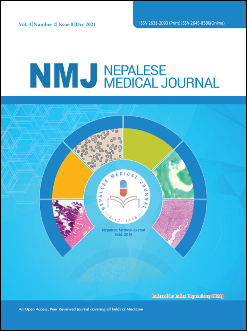Pseudoeosinophilia with Abnormal WBC Scattergram: an Important Diagnostic Clue on Hematology Analyzer
DOI:
https://doi.org/10.3126/nmj.v4i2.41920Keywords:
Malaria, Sysmex, PathologyAbstract
Malaria is one of the most common parasitic diseases causing a significant burden on health care, especially in India. Light microscopy, the gold standard for malaria diagnosis is time-consuming especially in a setup where the caseload is high and parasite index is low. Knowledge of abnormal scattergrams by the malarial parasite is very essential to suspect malaria and screen those cases thoroughly on a peripheral smear for accurate diagnosis. A timely and accurate diagnosis is crucial to the prognosis of this disease.
Herein, we report a case of a 40-year-old male from Punjab who presented to the emergency with fever and an altered sensorium. Analyzer showed characteristic pseudo eosinophilia with greying of neutrophil eosinophil zone with double eosinophil cluster. According to flagging rules because of eosinophilia, peripheral blood film (PBF) was made and examined, which revealed Plasmodium falciparum gametocytes.
Downloads
Downloads
Published
How to Cite
Issue
Section
License
Copyright (c) 2021 Swathi C Prabhu, Anita Tahlan, Shreya Sharma, Sarabmeet S Lehl

This work is licensed under a Creative Commons Attribution 4.0 International License.
This license enables reusers to distribute, remix, adapt, and build upon the material in any medium or format, so long as attribution is given to the creator. The license allows for commercial use.
Copyright on any article published by Nepalese Medical Journal is retained by the author(s).
Authors grant Nepalese Medical Journal a license to publish the article and identify itself as the original publisher.
Authors also grant any third party the right to use the article freely as long as its integrity is maintained and its original authors, citation details and publisher are identified.




